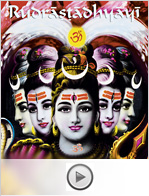Last Updated on January 10, 2025 by
 The Rudrashtadhyayi, or the 8 Chapters in Praise of Rudra, emanates from the Shukla Yajur Veda, one of the oldest expressions of spiritual wisdom known to mankind.Rudrashtadhyayi is the most acclaimed and celebrated hymn to Lord Shiva, and is chanted continually at all the jyotir lingams.
The Rudrashtadhyayi, or the 8 Chapters in Praise of Rudra, emanates from the Shukla Yajur Veda, one of the oldest expressions of spiritual wisdom known to mankind.Rudrashtadhyayi is the most acclaimed and celebrated hymn to Lord Shiva, and is chanted continually at all the jyotir lingams.
Rudrashtadhyayi celebrates Shiva, The Consciousness of Infinite Goodness, in his form as Rudra, the Reliever of Sufferings.The Vedic poems of the Rudrashtadhyayi convey the spiritual emotion, or bhava, of the passionate love and worship of Shiva.
Chanting them helps remove our suffering and grants us spiritual peace. The hymns are filled with inspiration, and the tones of their chanting conduct our vibrations to radiant purity.
The explanation of Rudrashtadhyayi in this video series grants the wisdom to move develop an intuitive understanding of the Sanskrit mantras and gives a clear explanation of the yoga system and yogic knowledge needed to incorporate this scripture into a personal spiritual discipline.